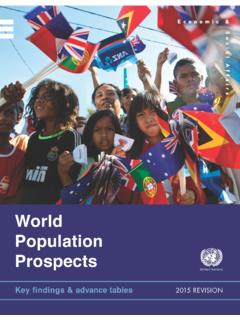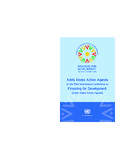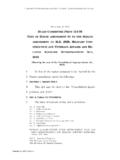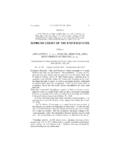Transcription of OECD-FAO Agricultural Outlook 2015-2024
1 OECD-FAO . Agricultural Outlook 2015 - 2024 . OECD-FAO . Agricultural Outlook 2015 - 2024 . This work is published under the responsibility of the Secretary-General of the OECD and the Director-General of FAO. The views expressed and conclusions reached in this report do not necessarily correspond to those of the governments of OECD member countries, or the governments of the FAO member countries. This document and any map included herein are without prejudice to the status of or sovereignty over any territory, to the delimitation of international frontiers and boundaries and to the name of any territory, city or area. The designations employed and the presentation of material in this information product do not imply the expression of any opinion whatsoever on the part of the Food and Agriculture Organization of the United Nations concerning the legal or development status of any country, territory, city or area or of its authorities, or concerning the delimitation of its frontiers or boundaries.
2 The names of countries and territories used in this joint publication follow the practice of the FAO. Please cite this publication as: OECD/Food and Agriculture Organization of the United Nations ( 2015 ), OECD-FAO Agricultural Outlook 2015 , OECD Publishing, Paris. ISBN 978-92-64-23190-0 (print). ISBN 978-92-64-23203-7 (PDF). Annual: OECD-FAO Agricultural Outlook ISSN 1563-0447 (print). ISSN 1999-1142 (online). FAO: ISBN 978-92-5-108808-1 (print). E-ISBN 978-92-5-108814-2 (PDF). The statistical data for Israel are supplied by and under the responsibility of the relevant Israeli authorities. The use of such data by the OECD is without prejudice to the status of the Golan Heights, East Jerusalem and Israeli settlements in the West Bank under the terms of international law.
3 The position of the United Nations on the question of Jerusalem is contained in General Assembly Resolution 181(II) of 29 November 1947, and subsequent resolutions of the General Assembly and the Security Council concerning this question. Photos credits: Cover ASO FUJITA/amanaimagesRF/Thinkstock photos; agustavop/Thinkstock photos; Magone/. Thinkstock photos; m-kojot/Thinkstock photos; luknaja/Thinkstock photos; wiratgasem/Thinkstock photos;. tomasworks/Thinkstock photos. Corrigenda to OECD publications may be found on line at: OECD/FAO 2015 . You can copy, download or print OECD content for your own use, and you can include excerpts from OECD publications, databases and multimedia products in your own documents, presentations, blogs, websites and teaching materials, provided that suitable acknowledgment of OECD and FAO as source and copyright owner is given.
4 All requests for public or commercial use and translation rights should be submitted to Requests for permission to photocopy portions of this material for public or commercial use shall be addressed directly to the Copyright Clearance Center (CCC). at or the Centre fran ais d'exploitation du droit de copie (CFC) at FOREWORD. Foreword T he Agricultural Outlook 2015 - 2024 , is a collaborative effort of the Organisation for Economic Co-operation and Development (OECD) and the Food and Agriculture Organization (FAO) of the United Nations. It brings together the commodity, policy and country expertise of both organisations and input from collaborating member countries to provide an annual assessment of prospects for the coming decade of national, regional and global Agricultural commodity markets.
5 The special feature on Brazil has been prepared in collaboration with analysts associated with the Minist rio da Agricultura, Pecu ria e Abastecimento (MAPA) and Empresa Brasileira de Pesquisa Agropecu ria (Embrapa). However, OECD and FAO are responsible for the information and projections contained in this document, and the views expressed in the special feature do not necessarily reflect those of Brazilian institutions. The baseline projection is not a forecast about the future, but rather a plausible scenario based on specific assumptions regarding the macroeconomic conditions, the agriculture and trade policy settings, weather conditions, longer term productivity trends, and international market developments. The projections of production, consumption, stocks, trade and prices for the different Agricultural products described and analysed in this report cover the years 2015 to 2024 .
6 The evolution of markets over the Outlook period is typically described using annual growth rates or percentage changes for the final year 2024 relative to a three-year base period of 2012-14. The individual commodity projections are subject to critical examination by experts from national institutions in collaborating countries and international commodity organisations prior to their finalisation and publication in this report. The risks and uncertainties around the baseline projections are examined through a number of possible alternative scenarios and stochastic analysis, which illustrate how market outcomes may differ from the deterministic baseline projections. The complete Agricultural Outlook , including more detailed commodity chapters, the full statistical annex and fully documented Outlook database, including historical data and projections, can be accessed through the OECD-FAO joint Internet site: The published Agricultural Outlook 2015 report provides: an overview of global agriculture and its prospects; an in-depth analysis of the Outlook for Brazilian agriculture and a consideration of some of the challenges facing the sector; and snapshots for each commodity with associated statistical tables.
7 The more detailed commodity chapters are contained in the OECD's iLibrary version of the report. OECD-FAO Agricultural Outlook 2015 OECD/FAO 2015 3. ACKNOWLEDGEMENTS. Acknowledgements T he Agricultural Outlook is jointly prepared by the OECD and FAO Secretariats. At the OECD, the baseline projections and Outlook report were prepared by members of the Agro-Food Trade and Markets Division of the Trade and Agriculture Directorate: Marcel Aden uer, Jonathan Brooks (Head of Division), Annelies Deuss, Armelle Elasri (publication co-ordinator), Hubertus Gay, C line Giner, Ga lle Gouarin, Pete Liapis, Claude Nenert, Koki Okawa, Graham Pilgrim and Gr goire Tallard ( Outlook co-ordinator). The OECD. Secretariat is grateful for the contributions provided by visiting experts Makgoka Lekganyane (South African Department of Agriculture, Forestry and Fisheries), Stephen MacDonald (United States Department of Agriculture), Juanita Rafajlovic (Agriculture and Agri-Food Canada), and Yumei Zhang (Chinese Academy of Agricultural Sciences).
8 The organisation of meetings and document preparation were provided by Martina Abderrahmane, Marina Giacalone-Belkadi, Aurelia Nicault and zge Taneli-Ziemann. Technical assistance in the preparation of the Outlook database was provided by Eric Espinasse and Frano Ilicic. Many other colleagues in the OECD Secretariat and member country delegations provided useful comments on earlier drafts of the report. At the FAO, the team of economists and commodity officers from the Trade and Markets Division contributing to this edition consisted of Abdolreza Abbassian, ElMamoun Amrouk, Pedro Arias, Boubaker BenBelhassen (EST Division Director), Concepcion Calpe, Emily Carroll, Kaison Chang, Merritt Cluff, Maria Adelaide D'Arcangelo, Michael Griffin, Yasmine Iqbal, Ekaterina Krivonos, Pascal Liu, Holger Matthey (Team Leader), Natalia Merkusheva, Jamie Morrison, Shirley Mustafa, Masato Nakane, Adam Prakash, Shangnan Shui, Timothy Sulser, and Peter Thoenes.
9 We thank visiting expert Shesadri Banerjee from the National Council of Applied Economic Research in India. Marion Delport and Tracy Davids from the Bureau for Food and Agricultural Policy at the University of Pretoria joined the team as consultants. Stefania Vannuccini from the FAO Fisheries and Aquaculture Department contributed, with technical support from Pierre Charlebois. Advice on natural resources and biofuel issues was provided by Marco Colangeli, Olivier Dubois and Michela Morese from the Global Bioenergy Partnership (GBEP). Research assistance and database preparation were provided by Claudio Cerquiglini, Julie Claro, Emanuele Marocco, Marco Milo, Mauro Pace and Pedro Sousa. This edition also benefitted from comments made by other colleagues from FAO and member country institutions.
10 FAO's James Edge, Michelle Kendrick, Yongdong Fu and Juan-Luis Salazar provided invaluable assistance with publication and communication issues. Chapter 2 of the Outlook , Brazilian Agriculture: Prospects and challenges , was prepared by the Secretariats at OECD and FAO, with input from Paola Fortucci and in collaboration with Brazilian colleagues. Alan Jorge Bojanic and Gustavo Chianca of the FAO Permanent Representation in Brazil provided input, and their colleagues Katia Lucia dos Santos Medeiros and Helena Carrascosa provided valuable guidance and comments on the initial 4 OECD-FAO Agricultural Outlook 2015 OECD/FAO 2015 . ACKNOWLEDGEMENTS. drafts. Julio Cesar Worman (FAO TCRS) and Juliana Rossetto (FAO Brazil) provided material on South-South co-operation.














